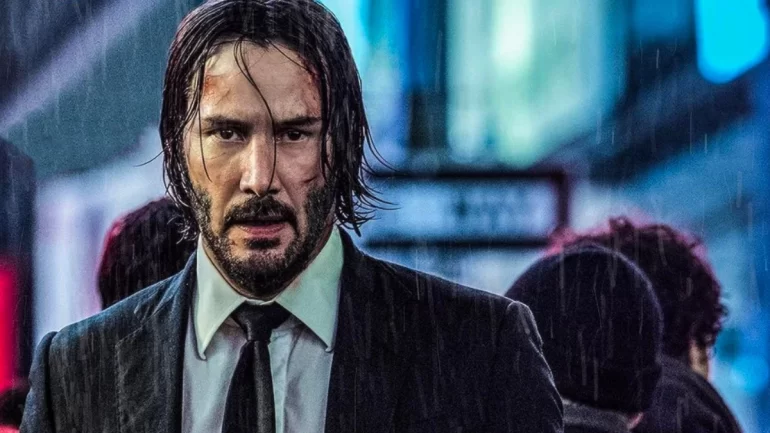How good to see you again so soon, Mr. Wick…
I remember watching John Wick for the first time and I can hardly believe that a decade has flown by since its release in 2014. What started as a simple tale of vengeance has evolved into a beloved franchise that redefined the action genre. Around that period that MCU was in full swing and there weren’t too many R rated action movies that were successful at the box office. John Wick combined breathtaking choreography, a unique narrative style, and a captivating underworld; the series has left an indelible mark on cinema.
To this day I’ll never forget when I met and interviewed Keanu Reeves in person in a hotel in downtown Toronto; he showed up in the John Wick attire and it was like a dream come true. As I’ve said before, The Continental television series was my idea except mine was to focus more on the various hitmen which was frankly a far better idea than what we ended up with.
When “John Wick” first hit theaters, it was immediately apparent that it wasn’t just another action movie. Directed by Chad Stahelski, a former stuntman, the film brought a refreshing mix of striking visuals and an emotional core.
The storyline revolves around a retired hitman seeking revenge for the death of his dog—a gift from his late wife. This poignant motivation set it apart from traditional revenge tales, offering depth and relatability amid the gunplay.
The most fascinating element of the Wick movies is the world building. I love the concept of The Continental with the gold coins and the killers can’t conduct business on Continental grounds.
Ian McShane is perfectly cast as the gentlemanly Winston. He exudes charm and authority, making him one of the most compelling figures in the series. Winston provides John with crucial information and guidance, all while adhering to the strict rules of the assassin underworld. His dual nature—both mentor and potential foe—adds layers to his character, making viewers constantly question his loyalties. As he navigates the treacherous waters of the High Table’s politics, Winston remains a steadfast ally, embodying the complex morality that defines the series. It’s also hard not to love Lance Reddick (R.I.P.) who plays the loyal Charon. As the concierge of the Continental, his calm demeanor and unwavering support for John Wick provide a sense of stability amidst all the chaos. Throughout the films, Charon’s interactions are brief yet impactful, highlighting the respect and camaraderie between him and John.
The franchise not only rekindled interest in stylized action but also influenced a wave of films and TV shows that followed, leaning towards more realistic and meticulously choreographed fight sequences. Beyond its cinematic feats, John Wick effectively introduced audiences to a vibrant world filled with assassins governed by their own codes of conduct, elevating the stakes and complexity within the genre. The movies got more stunning visually with each entry, but after 10 years I think the first film is still my favourite.
From its inception, the John Wick franchise has delivered some of the most memorable and groundbreaking action sequences in film history.
The original film’s opening sequence set the tone with raw emotion and skillful execution. Wick’s confrontation with various henchmen in his home, followed by a brutal beatdown at a nightclub, showcased the film’s unique mix of choreography and realism. The nightclub scene is still the highlight of the series for me especially seeing Daniel Bernhardt in such a key role as the villainous henchman Kirill.
For John Wick: Chapter 2 the sequel escalated the stakes with a thrilling chase scene through New York City. Wick’s relentless pursuit of Santino D’Antonio culminated in a fantastic shootout in the Continental Hotel, where the rules of the assassin underworld were put to the ultimate test. What was discussed in the first film about Wick killing someone with a pencil becomes a reality in one of the many showdowns he has with the other assassins.
One of the standout moments in the third movie Parabellum is undoubtedly the horse chase. Wick gallops through the streets of New York, using horses as weapons against his attackers. This creative choreography exemplifies the franchise’s talent for transforming ordinary settings into extraordinary battlefields. He also kills an opponent with a book in the opening few minutes which is arguably the best kill of the franchise.
The fourth and possibly final installment, Chapter 4 pushed boundaries even further, blending dramatic flair with martial arts. Adding action stars like Donnie Yen and Scott Adkins into the mix was one of the best decisions they made. The climactic duel at the Arc de Triomphe, the “Dragon’s Breath” shoot-out and the final showdown in a Parisian courtyard highlighted Keanu Reeves’ dedication to performing complex stunts.
I think the film goes on for too long and could have been trimmed but I still have a good time with it, if it is indeed the finale then it’s a fitting end for Wick’s exploits.
The influence of John Wick extends beyond its immediate success; it has altered the landscape of modern action filmmaking. Its emphasis on practical effects, long takes, and intricate choreography (with no shaky cam) provided filmmakers with a template for creating immersive, heart-pounding sequences. The franchise has proven that action films can possess depth while delivering adrenaline-pumping excitement.
As we celebrate ten remarkable years of John Wick, we honour not just a series of films but a cultural phenomenon that has redefined expectations within the action genre.
Be Seeing you, John…






